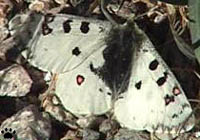 |
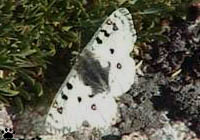 |
Some subspecies of Parnassius
clodius went extinct due to overcollecting
in the early 20th century. Mt. Evans, Colorado. |
Fighting butterfly poachers - Part 2
|

Courtship dance of Parnassius
hardwikey, Solo Khumbu, Nepal.
Mt. Everest is visible in the background. |
In 1997, I traveled to Nepal to study the situation
there. By that time, international butterfly trade became so widespread in Central
Asia, that even the most remote parts of the Himalaya and Tibet were regularly
visited by hunting expeditions. I tried to find out what areas were most heavily
exploited. One of the poachers' favorite hunting grounds was apparently Solo Khumbu
valley, including Sagarmatha National Park. |
| Most poachers, however, did not climb that high, preferring to
catch butterflies and moths in the Nature reserves around Katmandu, Pokhara and
along the road to Tibet. These last patches of remaining forests are surrounded
by agricultural lands and serve as the last refuges to small populations of native
species. Using light and chemical traps, hunters managed to wipe out the most
beautiful and rare insects. An average group of butterfly hunters takes tens of
thousands of specimens out of Nepal. | 
| 
Spring blooming in Nepal:
Rhododendron grandis,
Rh. arboreum, Magnolia
stellata, M. himalayana |

Street scenes, Katmandu. | 
| I warned the guards and supervisors of Nagarjun and
Chitwan Nature Reserves and members of Pokhara
city administration about those illegal activities. Later, our Fund sent official
letters to the late King of Nepal and to customs authorities, describing dangers
of insect poaching and main channels of smuggling. As a result, a large group
of poachers was arrested in Katmandu Airport a few months later. |
| Central and local administration in Nepal has often
been described as extremely slow and bureaucratic. Surprisingly, I found most
officials to be smart, effective, understanding and helpful. In the republics
of the former Soviet Central Asia, the situation is usually far worse. As regional
clans fight for administrative posts, most officials see their appointments as
a rare and brief opportunity to steal as much as possible, so they have little
or no time for anything else. |

Sacred City of Bukhara,
Uzbekistan |

Stork nest on a mosque,
Bukhara, Uzbekistan | 
Streets of Inner City of Khiva,
Uzbekistan | 
GurEmir,Tamerlan's tomb,
Samarkand, Uzbekistan |

Butterflies Arachnia burejana, Mt.
Oblachnaya,
Ussuriland, Russia.
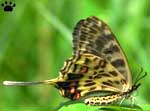
Sericinus telamon is almost extinct
in Russia because of overcollecting
and habitat destruction. Ussuriland.
| Central Asia is not the only area where the international
insect trade is destroying the local fauna. Among the most intensively exploited
areas are Southeast Asia, Indonesia, the Philippines, New Guinea, Tropical America,
and, in the last few years, China and South-Eastern Russia, particularly Ussuriland.
In Southeast Asia, Madagascar and Latin America, there are large companies with
hundreds of employees, selling insects to Europe, Japan and USA. Although these
people are usually not qualified enough to hunt rare species, they kill hundreds
of thousands of the most beautiful butterflies, moths and beetles to sale them
as souvenirs. The disappearance of large insects is often followed by decline
in some bird and bat species, as well as by local extinctions of plants which
depend on butterflies or beetles for pollination. Other groups depend on insect
larvae for food - moles, shrews, and small opossums, for example, can become extinct
if beetle larvae disappear from the forest floor. |
| InUssuriland,
butterfly hunters look for rare species as well as for large ones. Some species
are already on the verge of extinction, others are rapidly declining. Another
problem here is the installation of bright lights in remote villages, timber factories,
gas stations and airfields. These lights attract millions of insects, some of
them rare and local. For many years, a state-owned factory called "Nature and
Education" killed thousands of butterflies and moths outside Ussuri Nature Reserve.
Mounted insects were then sent to schools and regional museums. Just as the efforts
of ecologists resulted in its closure, the Perestroika started, and the factory
was privatized. For 10 more years, it kept killing insects, this time for souvenir
trade and for foreign collectors. Some species became rare or disappeared in the
area. In 1998, the joint campaign by our Fund and local environmental groups finally
forced regional authorities to close the factory and confiscate its UV traps. |

Actias artemis (above),Brahmea
lederei (below), and other large
moths are especially vulnerable
to light pollution. Ussuri
Nature Reserve, Ussuriland
 |

Eusapteryx ladislai, little-known
moth of taiga forest, Ussuriland. | 
Zephirus pugachukii - tiny,
extremely rare Ussuriland butterfly. | 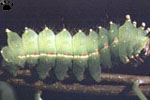
Larva of Actias artemis moth,
Ussuriland. |

Papilio maaki, Ussuriland. | 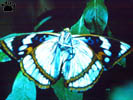
Iphiria shrenkii, Ussuriland. | As large and beautiful butterflies are killed in hundreds of thousands
to be sold as souvenirs, small species do
not attract much attention - they just quietly die out because of habitat destruction, chemical
and light pollution. |
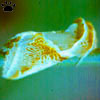
Caliona rubi, uncommon
forest moth, Ussuriland. | 
Phesia tremulae,
Ussuriland. | 
Saturnidae moths attracted by street
light will be eaten by birds at dawn. | 
Erebomorpha
sp., Ussuriland. | 
Vernalia crataega, tiny
rare moth, Ussuriland. |
| The next major battlefield in the war on insect trade
will be China. Expeditions from Germany, Russia, Ukraine, Czech Republic and Japan
have already established smuggling routes in Tibet and Manchuria. Now they try
to establish new "hunting grounds" in Szechwan, Yunnan, Xinjian and other parts
of the country. Very few of them get caught: in 1999, a large Russian group was
arrested for smuggling 16 kg of rare butterflies from the country. They were all
released after paying a fine (equal to the market price of one Parnassius hardwickii
from Tibet). As the country gradually becomes more open for tourists, there is
little doubt that even the most inaccessible places, such
as Kuen Lun mountains, will soon be regularly exploited by "entomological" expeditions. | 
Saturnia fugax, endemic to
southern Ussuriland,
North
Korea and Manchuria. |
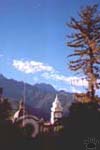 |  |  |  | | Old cities of South America: Merida (Venezuela), Villa de Leiva (Colombia),
Cuzco (Peru), Machu Picchu (Peru). |

Butterflies on a beach,
Rio Alto Madre del Dios, Peru.

Butterflies on my backpack,
Manu National Park, Peru. | South America is home to some of the World's
most beautiful butterflies, such as Morphidae and many of Papilionidae
species. The continent had been heavily exploited by butterfly-hunting expeditions
in the early 20th century, but the situation here has considerably improved in
the 1950-s and 60-s. Unfortunately, now it is rapidly getting worse. Catching
butterflies for souvenir trade is an important source of income for young people
in some villages. In many places around Iquitos, Peru, school-age children make
more money than their hard-working parents, simply by catching thousands of butterflies
and other large insects and selling them to insect dealers. |
| People in many parts of Latin America are so poor, and reproduce so fast, that they'll inevitably destroy
any remaining flora and fauna in populated areas. It is probably too late to try to save biodiversity outside national
parks and other preserves. But the situation in many parks is not much better, particularly for insects. More often than not,
park administration doesn't consider invertebrates worth protecting, so collecting parties can operate freely inside the protected area.
| 
Church of Aymara Indians, Bolivia. |

Sunday in a highland village, Peru. | Even if park guards know that all parts of the ecosystem
must be protected, they are too busy trying to control illegal hunting, logging,
coca planting and forest burning. Parque Nacional Manu
is one of the best-protected Natural areas in Latin America. Still, in 1995 it
was not unusual to see large groups of people of all ages, patrolling forest roads
in the foothills in search of Morpho and other large butterflies. At night,
they collected hundreds of moths with UV lights and chemical baits. |
| It was very easy for me to explain the importance
of insect conservation to park stuff, but it took them three years to stop such
activities in the park. Almost everywhere outside Manu, butterfly business is
growing rapidly. It doesn't attract as much attention as fur or pet trade. So,
few people realize that having a box of stuffed butterflies in your room is not
better than wearing an ocelot fur coat, or keeping and endangered parrot as pet.
|

Ara chloroptera - another
victim of illegal animal trade. |
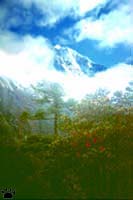
Himalayan forest in the range of
Parnassius hardwickii, Nepal | The main problem in fighting international insect trade is lack of information. Even people responsible
for the enforcement of environmental laws often pay little attention to insects smuggled out or in their
countries. Insect collectors never tell their secrets, and professional
entomologists are more interested in agriculture pests and other economically
important species than in rare ones. If the situation will not change within the next decade,
hundreds of insects will be hunted to extinction, mostly without even being noticed by scientists.
As long as open trade in insects and seashells is allowed in USA and
Europe, the mass extinction of these groups will continue, fed by our ignorance and greed. |
| Insect dealers feel so confident that they often sell rare and endangered
species online. Web search by a scientific name like Morpho or Parnassius
would yield 2-3 sites with large parties of specimens for sale. It is not unusual
to see offers like "discounts on 1000+ series", even for the most vulnerable species.
Most of these sites are based in Eastern Europe, but some gangs have branches
in USA and Western Europe. Every time I see a new site of this kind, I try to
inform Russian office of WWF, or other authorities, but new sites seem to appear
much faster than old ones are closed. So far, I've succeeded only in two cases,
and, except for one group arrested in China (see above), no online insect dealer
has had any serious trouble. | 
Canyon habitat of
P. ariadne, Altai |

Giant moth Attacus
edwardsi, Banaue, Luzon. | My trip
to the Philippines, once a major center of biodiversity, was particularly
depressing. This small country has turned into one huge human settlement, and
the remaining islands of natural habitat (usually the size of an urban park) are
separated by many miles of merged-together towns, villages, fields, and badly
polluted seas. Park guards in many Nature preserves were surprisingly well-informed
about the problems of illegal insect collecting, but they were unable to effectively
protect even large animals and trees from poaching. Some islands have already
lost their forests completely, so that thousands of endemic species have gone
extinct before even being described. On the island of Mindoro, the last remaining
patch of lowland rainforest is located inside a huge penal colony, and one of
the best-paying jobs of the inmates is catching butterflies and moths for sale.
All the rarest species have been hunted to extinction already, so now they collect
huge numbers of more common ones, to sell as souvenirs. |
| It looks like the majority of the world's butterfly and moth species will
go extinct within the next few decades. They will be followed by an uncountable
number of plants and animals that depend on them for food or pollination. What
it will be like, can be seen on Hawaiian Islands, where the entire native ecosystem
is falling apart, and most of local flora and fauna is being replaced by introduced
species. The olulu plant was probably pollinated by a hawk moth, but this moth
became extinct before even been discovered. Now all remaining olulus depend on
hand pollination by park rangers. Most other plant species are not so lucky and
don't have rangers at hand, so they simply disappear from the face of Earth if
their pollinators are gone. Each plant species that dies out is followed by numerous
invertebrate species depending on it, and so on. | 
Olulu (Brighamia insignis),
Kilawea Point, Hawaii. |
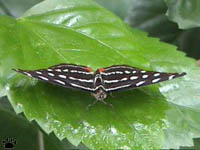 |
 |
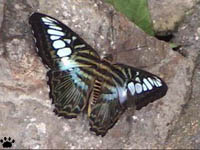 |
| Nymphalid butterflies feeding on tree sap, Manu National Park, Peru. |
Page 3
Back to Page 1
Home |